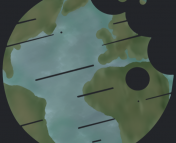Written by Erica Sawczynec (UT Austin)
Disclaimer: “Beyond astro-ph” articles are not necessarily intended to be representative of the views of the entire Astrobites collaboration, nor do they represent the views of the AAS or all astronomers. While AAS supports Astrobites, Astrobites is editorially independent and content that appears on Astrobites is not reviewed or approved by the AAS.
The Unfolding of a Travesty
Devastated does not begin to describe how I feel about the events currently unfolding on my home island of Maui. On Tuesday, August 8th 2023, hurricane Dora reached its closest southern approach to Maui County & Hawaiʻi Island, imparting wind gusts up to 60–80 MPH. Several utility poles were knocked down by the high winds on Maui causing power outages in Kula and Lāhainā. Likely due to these winds and power outages, Lāhainā also faced an almost complete cell service blackout.
Early in the morning on August 8th, 2023 a brushfire was reported in Kula, and evacuations of residents began around 4 AM. Several hours later a larger brush fire was reported in Lāhainā but was reportedly contained as of 9 AM. However, only hours later the same Lāhainā brushfire flared up, likely fanned by the winds from Dora, and quickly grew in size and intensity. Since both Kula and Lāhainā were without power, notifying residents to evacuate was difficult. Further complicated by no cell service in Lāhainā, many residents reported never receiving an evacuation notice at all, only knowing of the fire when faced with flames or smoke directly. Although Hawaiʻi has the largest integrated outdoor siren warning system in the world, the civil defense sirens never sounded to warn residents of the coming fires. Many residents of both Lāhainā and Kula had little to no notice of the fires and many fled their homes with only the clothes on their back and what they could carry in their hands.
The Lāhainā fire jumped Honoapiʻilani Highway, the primary route to get in and out of Lāhainā, late in the afternoon and spread a mile a minute, reaching the waterfront within an hour. Those evacuating within the town were faced by gridlocked traffic, brought on by people abandoning their cars in the street as they ran to the ocean for safety. Those in the ocean spent hours there, watching as the flames engulfed the town and cars in the street began to explode, some hanging on to debris and drifting out to sea. Those who made it to the ocean risked dying of hypothermia or drowning after spending hours in the water. Those who did not make it out in time perished in the streets, in buildings, or in cars trapped in gridlock. There is a continuing effort to find the over 1,000 people reported as missing.
An Insurmountable Loss
As the sun rose the next morning, the extent of the damage became more clear (estimates here are sourced from Pacific Disaster Center (PDC) and the Federal Emergency Management Agency (FEMA) via Maui County). 676 acres burned in Kula affecting 544 structures, 96% of which were residential—an estimated $434 million in damage. In Lāhainā, 2,170 acres burned affecting 2,719 structures, 86% of which were homes and apartments. While the damage is estimated to be in excess of $5.5 billion, for kānaka (Native Hawaiians) the cost is much higher. Lāhainā once hosted the island of Mokuʻula, which became the capital of the Hawaiian Kingdom—later buried under a baseball field. The Waiola Church, lost in the fire, housed the beginning of Christianity on Maui and is a resting place for many aliʻi (high chiefs and nobles). Lāhainā has always been a source of great mana (power) for the Hawaiian people, the loss of Lāhainā feels insurmountable.
While shelters were set up in several places across the island of Maui, residents of Lāhainā were hesitant to leave the West Side even without food, water, power, or cell service as many were unsure when they would be allowed to return home if they left. Additionally, many did not know of the shelter locations, government evacuation plans, or news about the fire since there was no way of accessing social media, news networks, radio, or family and friends by phone. While residents and tourists were allowed to evacuate Lāhainā, there were strict no re-entry rules, only allowing first responders to re-enter Lāhainā. This has continued for several days as the fire still eludes containment (as of 08/15/2023).
The Meaning of Aloha
It is commonly known that Hawaiʻi is the Aloha State. Many know Aloha as a greeting, hello or goodbye, but I think Aloha, and the Aloha Spirit, is better defined by the following excerpt from Chapter 5 of Hawaiʻi Revised Statutes:
“Aloha” means mutual regard and affection and extends warmth in caring with no obligation in return. “Aloha” is the essence of relationships in which each person is important to every other person for collective existence. “Aloha” means to hear what is not said, to see what cannot be seen and to know the unknowable.
In times of crisis, I have always watched my community rally around those in need, and the wildfire crisis in Lāhainā and Kula is no different. Since the government has maintained strict road access, the community has taken to accessing Lāhainā and those in need via the ocean sending boat after boat filled with supplies bought and donated by those in the community. Volunteers looking out for and posting the sign-in sheets for shelters so the community can find their lost loved ones. Kānaka and Kamaʻāina (Hawaiʻi residents) on the mainland and local to Hawaiʻi immediately started sales benefiting those affected by the fires and collected donations to send to Maui via barge. When the community feels that the government is not providing the aid required, they will step in and deliver the aid themselves—regardless of the mental, physical, or monetary cost.
The Astronomy Community’s Kuleana (Responsibility)
In the astronomy community, many of us are connected to Hawaiʻi in some way. Many of us have used telescopes built on the most sacred parts of the illegally annexed lands of the Hawaiian Kingdom for our personal career growth or in the name of scientific curiosity. Many of us have visited the islands either for conferences, workshops, observing runs, or to attend school. It is our kuleana (responsibility) to give back to and show up for these communities in their time of need, right now the community in need is the island of Maui. Showing up means donating money or time (if you are on island), canceling future vacations, and amplifying the voices of the Hawaiian people as more information of their needs comes out.
There are many different avenues to donate to support those affected in Kula or Lāhainā by the wildfires, these are the primary fundraisers where 100% of the proceeds go to the affected communities:
- Council for Native Hawaiian Advancement’s Kākoʻo Maui: CNHA is partnering with several organizations to match up to $1,500,000+ in community donations for ʻohana impacted by the devastating wildfires on Maui.
- Hawaiʻi Community Foundation: The Maui Strong Fund was created to provide community resilience with resources for disaster preparedness, response, and recovery. They will provide resources that can be deployed quickly, with a focus on relief and recovery for the devastating wildfires.
- Maui United Way’s Maui Fire Disaster Relief: All donations provide direct relief to families and nonprofits directly affected by the Maui Fire Disaster.
- Maui Food Bank’s Disaster Relief for Maui: With every $1 donated, the Maui Food Bank can provide 4 meals to the hungry living in our island community. Give now and together we can make a difference.
- Hawaiʻi People’s Fund’s Maui Aloha: The People’s Response: Support our frontline grassroots heroes mobilizing to mālama ʻohana affected by the wildfires on Maui. Funds raised through this effort will move critical resources to past, present, and future community partners committed to seeing our beloved community through this storm.
- Maui Rapid Response’s Maui Mutual Aid: Grassroots monetary fund being distributed quickly to vulnerable residents in need
- Maui Humane Society’s Fire Relief Fund: We need donations. Pet food, pop-up kennels, and litter are pivotal to providing sustenance to animals, as staff and volunteers are putting together kits for families and animals in need. For those on the mainland looking to help, supplies can be delivered directly to us via our Amazon Wishlist and monetary donations will be crucial to cover the costs of the lifesaving medical treatments necessary to save animal lives affected by the fires.
- Donate Directly to a Family in Need: A list of families affected by the wildfires, each with a little blurb about the family, their situation, and their need.
For a more comprehensive resource including information for residents, mutual aid drop off sites, and donation links please visit the Hawaiʻi Alliance for Progressive Action’s (HAPA) Support Maui-Help & Resources page compiled by Nanea Lo the HAPA Administrative & Programs Coordinator.
Astrobite edited by Alexis Ann K. Acohido (Canada France Hawaiʻi Telescope) and Suchitra Narayanan
Featured image credit: Matthew Thayer/The Maui News
About the Author: Erica Sawczynec grew up on the island of Maui in Kīhei. She received her undergraduate degree in Physics from the University of Hawaiʻi at Mānoa. Now as a rising third year graduate student at the University of Texas at Austin, she studies near-infrared (NIR) spectroscopy instrumentation with the IGRINS team. She also use high resolution NIR spectrographs, like IGRINS, to study circumstellar disk evolution using molecular hydrogen.




